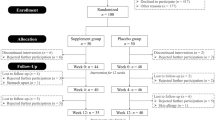Abstract
Purpose
Guanidinoacetic acid (GAA) is an intermediate in the biosynthesis of creatine (Cr), yet its use in human nutrition is limited due to a lack of a clear understanding of its’ dose–response effect. Thus, the purpose of this study was to investigate the effect of three different dosages of GAA (1.2, 2.4 and 4.8 g/day) administered for 6 weeks on serum and urinary variables related to GAA metabolism.
Methods
Forty-eight healthy volunteers participated in the randomized, placebo-controlled, double-blind, repeated-measure study. At baseline, after 1, 2, 4 and 6 weeks, participants provided both fasting blood samples and 24-h urine.
Results
GAA intervention significantly increased serum and urinary GAA, Cr and creatinine as compared to placebo (P < 0.05). Differences were found for serum GAA and Cr responses between the three GAA dosages, with high-dose GAA resulting in a greater increase (P < 0.05) in the plasma concentration of both variables as compared to other GAA dosages. In GAA groups, fasting plasma total homocysteine (T-Hcy) increased by 3.5 μmol/L on average at post-administration, yet no dose–response differences were found between trials. Serum B vitamins were not affected by either placebo or GAA intervention (P > 0.05).
Conclusion
Results indicate that low-to-high dosages of exogenous GAA can increase serum concentrations of Cr and T-Hcy while not depleting the B vitamins pool available for remethylation of homocysteine. Clinical trial registration: ClinicalTrials.gov, identification number NCT01133899.


Similar content being viewed by others
References
Baker DH (2009) Advances in protein-amino acid nutrition of poultry. Amino Acids 37:29–41
Wyss M, Kaddurah-Daouk R (2000) Creatine and creatinine metabolism. Physiol Rev 80:1107–1213
Carducci C, Birarelli M, Leuzzi V, Carducci C, Battini R, Cioni G, Antonozzi I (2002) Guanidinoacetate and creatine plus creatinine assessment in physiologic fluids: an effective diagnostic tool for the biochemical diagnosis of arginine: glycine amidinotransferase and guanidinoacetate methyltransferase deficiencies. Clin Chem 48:1772–1778
Selhub J (1999) Homocysteine metabolism. Annu Rev Nutr 19:217–246
Sotgia S, Carru C, Caria MA, Tadolini B, Deiana L, Zinellu A (2007) Acute variations in homocysteine levels are related to creatine changes induced by physical activity. Clin Nutr 26:444–449
Ostojic SM, Niess B, Stojanovic M, Obrenovic M (2013) Coadministration of methyl donors along with guanidinoacetic acid reduces the incidence of hyperhomocysteinemia compared to guanidinoacetic acid administration alone. Br J Nutr 110:865–870
Ostojic SM, Niess B, Stojanovic M, Obrenovic M (2013) Creatine metabolism and safety profiles after 6-week oral guanidinoacetic acid administration in healthy humans. Int J Med Sci 10:141–147
Ostojic SM, Niess B, Stojanovic MD, Idrizovic K (2014) Serum creatine, creatinine and total homocysteine concentration-time profiles after a single oral dose of guanidinoacetic acid in humans. J Funct Foods 6:598–605
Craig CL, Marshall AL, Sjöström M, Bauman AE, Booth ML, Ainsworth BE, Pratt M, Ekelund U, Yngve A, Sallis JF, Oja P (2003) International physical activity questionnaire: 12-country reliability and validity. Med Sci Sports Exerc 35:1381–1395
European Food Safety Authority (2009) Safety and efficacy of guanidinoacetic acid as feed additive for chickens for fattening. EFSA J 988:1–30
Persky AM, Brazeau GA, Hochhaus G (2003) Pharmacokinetics of the dietary supplement creatine. Clin Pharmacokinet 42:557–574
Jaki T, Wolfsegger MJ, Ploner M (2009) Confidence intervals for ratios of AUCs in the case of serial sampling: a comparison of seven methods. Pharm Stat 8:12–24
Tsubakihara Y, Hayashi T, Shoji T (2012) Guanidinoacetic acid (GAA) in patients with chronic kidney disease (CKD) and diabetes mellitus (DM). Kid Res Clin Pract 31:A81
Borsook ME, Borsook H (1951) Treatment of cardiac decompensation with betaine and glycocyamine. Ann West Med Surg 5:830–855
Graybiel A, Patterson CA (1951) Use of betaine and glycocyamine in the treatment of patients with heart disease: preliminary report. Ann West Med Surg 5:863–875
Borsook ME, Billig HK, Golseth JG (1952) Betaine and glycocyamine in the treatment of disability resulting from acute anterior poliomyelitis. West Med Surg 6:423–427
Tsubakihara Y, Suzuki A, Hayashi T, Shoji T, Togawa M, Okada N (1999) The effect of guanidinoacetic acid supplementation in patients with chronic renal failure. In: Mori A, Ishida M, Clark JF (eds) Guanidino Compounds in Biology and Medicine, vol 5. Blackwell Science Asia, Singapore, pp 139–144
Jahangir E, Vita JA, Handy D, Holbrook M, Palmisano J, Beal R, Loscalzo J, Eberhardt RT (2009) The effect of l-arginine and creatine on vascular function and homocysteine metabolism. Vasc Med 14:239–248
Refsum H, Ueland PM, Nygard O, Vollset SE (1998) Homocysteine and cardiovascular disease. Annu Rev Med 49:31–62
Morris MS (2003) Homocysteine and Alzcheimer’s disease. Lancet Neurol 2:425–428
Craig SAS (2004) Betaine in human nutrition. Am J Clin Nutr 80:539–549
Gamble MV, Ahsan H, Liu X, Factor-Litvak P, Ilievski V, Slavkovich V, Parvez F, Graziano JH (2005) Folate and cobalamin deficiencies and hyperhomocysteinemia in Bangladesh. Am J Clin Nutr 81:1372–1377
Setoue M, Ohuchi S, Morita T, Sugiyama K (2008) Hyperhomocysteinemia induced by guanidinoacetic acid is effectively suppressed by choline and betaine in rats. Biosci Biotechnol Biochem 72:1696–1703
Allen PJ (2012) Creatine metabolism and psychiatric disorders: does creatine supplementation have therapeutic value? Neurosci Biobehav Rev 36:1442–1462
Acknowledgments
This study was supported by Grant No. 175037 from Serbian Ministry of Education, Science and Technological and Grant No. AN_85E_S09 from AlzChem AG. The authors thank the research participants for their dedication. We thank Dr. Radmila Vrzic and Dr. Nadezda Majkic for their assistance with biochemical data retrieval; Mirjana Stojanovic for statistical support; and the staff of the exercise physiology laboratory, Bojan Medjedovic, Dragoljub Veljovic, Kristina Kanostrevac and Milan Barbir. The authors are grateful for the technical and scientific advice provided by Dr. Barbara Niess (AlzChem AG, Trostberg).
Conflict of interest
The authors declare that they have no conflict of interest.
Author information
Authors and Affiliations
Corresponding author
Rights and permissions
About this article
Cite this article
Ostojic, S.M., Stojanovic, M., Drid, P. et al. Dose–response effects of oral guanidinoacetic acid on serum creatine, homocysteine and B vitamins levels. Eur J Nutr 53, 1637–1643 (2014). https://doi.org/10.1007/s00394-014-0669-0
Received:
Accepted:
Published:
Issue Date:
DOI: https://doi.org/10.1007/s00394-014-0669-0




